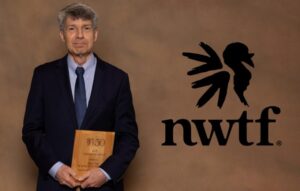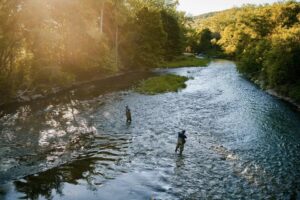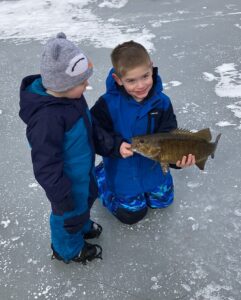A nice crowd attended the Silvio O. Conte Awards Banquet which was held at the Cheshire Rod & Gun Club last Saturday evening to honor the Berkshire County League of Sportsmen (BCLS) 2022 award winners. Past BCLS President, Mark Jester, did his usual yeoman’s job as emcee.
Jester mentioned how Silvio Conte dedicated his life to conserve for future generations the ability to enjoy the same opportunities that he did. Everyone raised a glass to thank Conte for the values of sportsmanship, conservation, and environmental stewardship that he passed on so passionately
The evening was also dedicated to the memory of the late Fred Andrews. “We remember Fred Andrews tonight” said Jester, “a true leader and dedicated advocate for sportsmen in Berkshire County. As a former president and delegate of the BCLS, Fred worked tirelessly to build one of the most influential organizations in Massachusetts.” “Fred’s humor and ability to poke fun at even the most powerful politicians like US Representative Silvio Conte and Massachusetts Governor Jane Swift while honoring them at the same moment endeared him to many in the sportsman community. His wit and humor made him a beloved figure and he will always be remembered for his contributions to the outdoors and sportsman community.”
Incidentally, for several years, Fred was the gifted writer and the editor of the hugely popular monthly newspaper “Into the outdoors.” He passed away 20 years ago, but he is still missed.
Jester mentioned that we had with us that night a young fellow, Hunter Lawson, who went out on his first turkey hunt with his dad Dan Lawson. Dan has an amazing story to tell us about Hunter’s first hunt, but space does not allow me to relate it here. Look for his article next weekend.
After a delicious meal, the various 2022 Sportsmen Awards were presented.
Stephen Sears of Dalton was selected the 2022 Berkshire County Sportsman of the Year. Sears served 6 years on the MA F&W Board and is its current chairman. He received the award for his lifelong dedication and leadership to preserve the natural resources of the Commonwealth.
Steve’s father, Fred Sears, helped him catch his first trout when he was 3 years old, one of the greatest moments of his life. He is so proud to later have written the Conservation Restrictions on the Boulders, which is now managed by BNRC. He helped protect the very place where he caught his first trout. Around 1971 he began stocking trout with Gige Darey. He related how every day he and his friends would bring their guns to school and put them in their lockers and then hunt after school. Now, that doesn’t happen anymore.
“If you want to make a change”, said Sears, “don’t protest, get involved with an organization, try to arrive at the top and then make changes.” At Crane & Co he was able to do that and ultimately wrote Conservation Restrictions on property that is now protected which probably wouldn’t be because they sold the company. He worked with Mt Greylock Ski Club for 10 years to put a Conservation Restriction on that land. He commented on the Berkshire Eagle as being an important part of our community. Most counties don’t have a newspaper, and he commended the owners and staff for its coverage of sportsmen’s activities. He expressed pride in being a representative for MassWildlife, which he doesn’t take lightly.
The Sportsmen’s Appreciation Award was presented to Joe Miraglia of Ashfield Joe, a native of Pittsfield who now lives in Ashfield, is very involved in the Ashfield Sportsmen’s Club. “You will see him in the Berkshires many times” said Jester, “helping with various programs, fishing programs in June, and making donations to our organization.” He has been involved in the outdoors since being a little boy. He is a great turkey hunter and makes tremendous turkey calls. He has helped with pheasant programs and teaching turkey hunting. He is being recognized for the dedication and leadership to preserve and promote the rich tradition and will forever be appreciated for all his efforts.
The Lifetime Achievement Award was posthumously presented to the late Fred Moran of Adams. He was an ardent supporter of the BCLS, a legend in the flyfishing world, owner of Points North Outfitters in Adams, a guide, and taught people how to fly fish. He was a quiet person who advocated for sportsmen’s rights and was a member of the Taconic Chapter TU. Alongside with his good friend and rod maker Digger Degere, he put on many public demonstrations and was on the Board of the Hoosic River Watershed. “He received the award “In recognition of Fred’s role in the preservation of the natural resources of Berkshire County. His legacy, his patience and passion will forever inspire future generations”
Speaking on behalf of the Moran family, son Kevin said, “Receiving this award would have made Fred Moran very proud. He greatly respected this organization and its constituency. As an educator and sportsman and specifically as a fisherman, Fred took great pleasure in teaching hundreds and perhaps thousands of people to fly fish and along the way, like all of you, Fred raised his family to be conservation minded to enjoy and respect nature and its creatures and to know that our place within it means working to ensure that our children and grandchildren and beyond will enjoy the peace and tranquility that comes with casting a size 16 Olive Caddis out into the Deerfield river on a warm June evening or a size 12 March Brown on the Hoosic on a crisp afternoon in April. So, on his behalf Fred’s family represented here tonight by Marilyn, his wife of 50 years, his sons, daughter in law and granddaughters he accepted the award and thanked the League.
Incidentally, this was not the first time that Marilyn Moran was at the BCLS podium. She was presented the Lifetime Achievement Award for her involvement in the Casting for Recovery Program. The mission of CFR is to enhance the lives of women with breast cancer through fly fishing.
The John Zuber Award was presented to Eric Dupont of Lee. He was recognized for introducing youths to the shooting sports and getting them involved with the Lee Sportsmen’s Association. He expressed pride in receiving the award. He noted that there are two firearms communities out there, this one that never gets any press and the one that we unfortunately get to read about all too often in the news. He encouraged everyone to remember that we can get out there and make our sporting community known for what it is.
Incidentally, John Zuber was one of the founders and past president of the BCLS. An avid hunter/fisherman who traveled all over the world hunting, filming his hunts and giving presentations. He was a valued member of the Pittsfield Sportsmen’s Club who was very involved with the youth and encouraged them to get involved with the outdoors. Because of that, the BCLS opted to create an award in remembrance of him.
Trout stocking
Subject to change, the following local waters were scheduled to be stocked with trout last week: South River and Swift River in Ashfield, Yokum Brook in Becket, Dry Brook and South Brook in Cheshire, Littleville Reservoir and Westfield River Middle Branch in Chester, West Branch Brook and Westfield River East Branch in Chesterfield, Mill Brook, Swift River, Westfield Brook and Westfield River East Branch in Cummington; Wahconah Falls Brook and Sacket Brook in Dalton, North Pond in Florida, Swift River in Goshen, West Brook and Williams River in Great Barrington, Kinderhook Creek in Hancock, Windsor Brook in Hinsdale, Little River, Littleville Reservoir, Westfield River Mainstem, Westfield River Middle Branch and Westfield River East Branch in Huntington; Laurel Lake, Housatonic River C&R, Beartown Brook, Hop Brook and West Brook in Lee; Laurel Lake in Lenox, Factory Brook and Westfield River Middle Branch in Middlefield, Westfield River Main Stem in Mongomery, Farmington River in Otis, Trout Brook in Peru, Onota Lake and Sackett Brook in Pittsfield, Mill Brook in Plainfield, Westfield River Main Stem in Russell, Farmington River in Sandisfield, Housatonic River C&R and Larrywaug Brook in Stockbridge, Farmington River in Tolland, Depot Brook in Washington, Williams River in West Stockbridge, Westfield Brook in Windsor, and Bronson Brook, Little River, West Branch Brook, Westfield River Middle Branch and Trout Brook in Worthington.
















